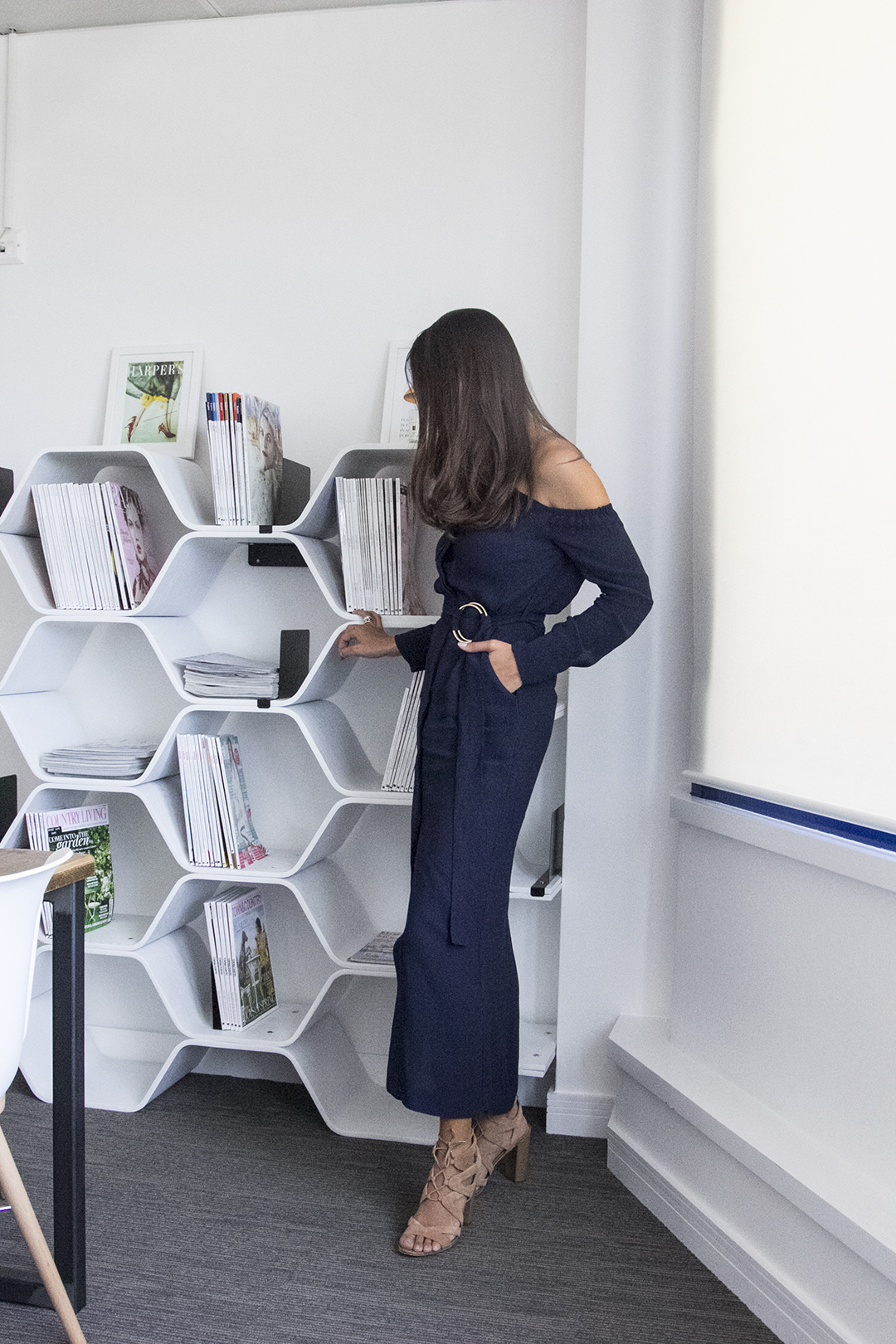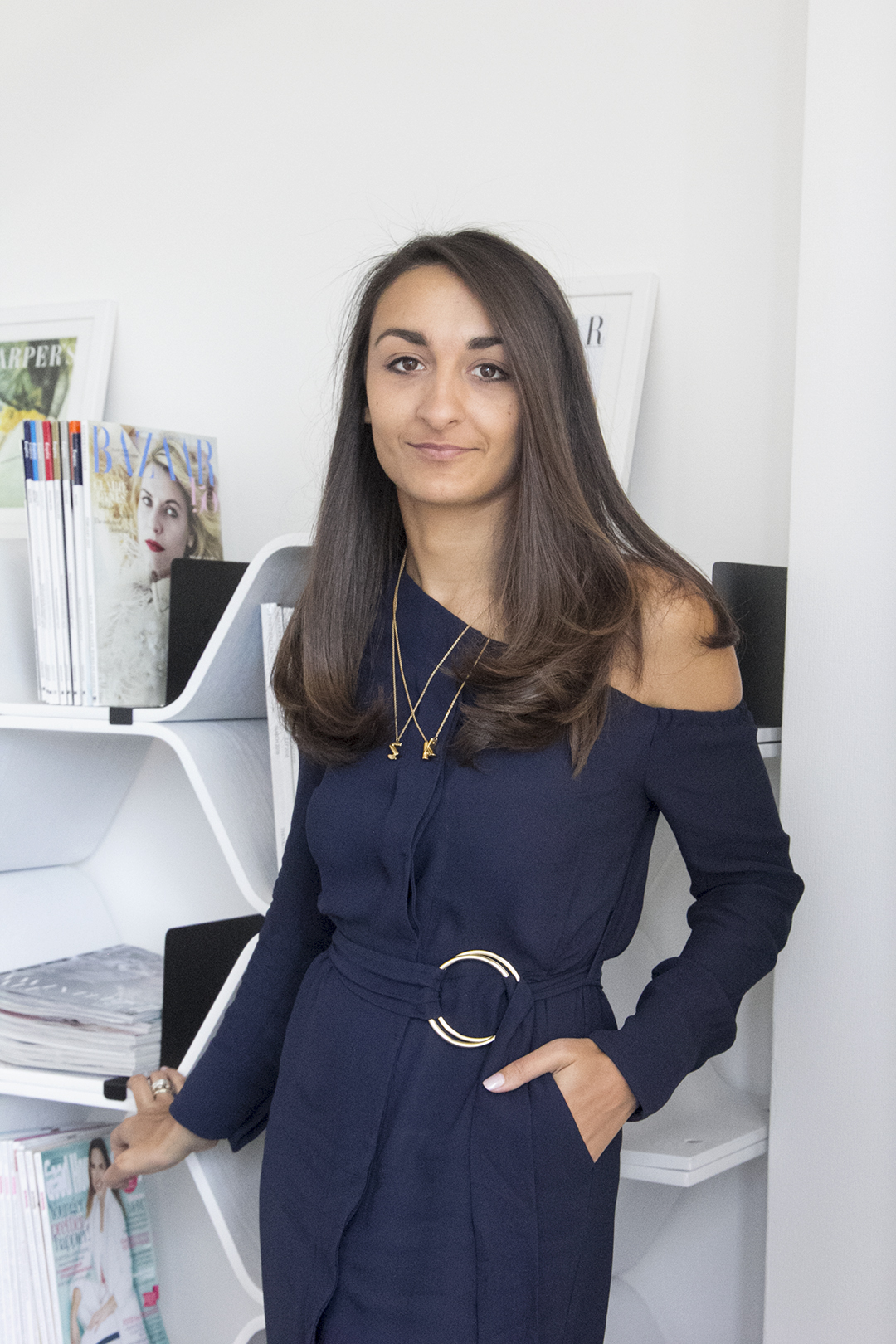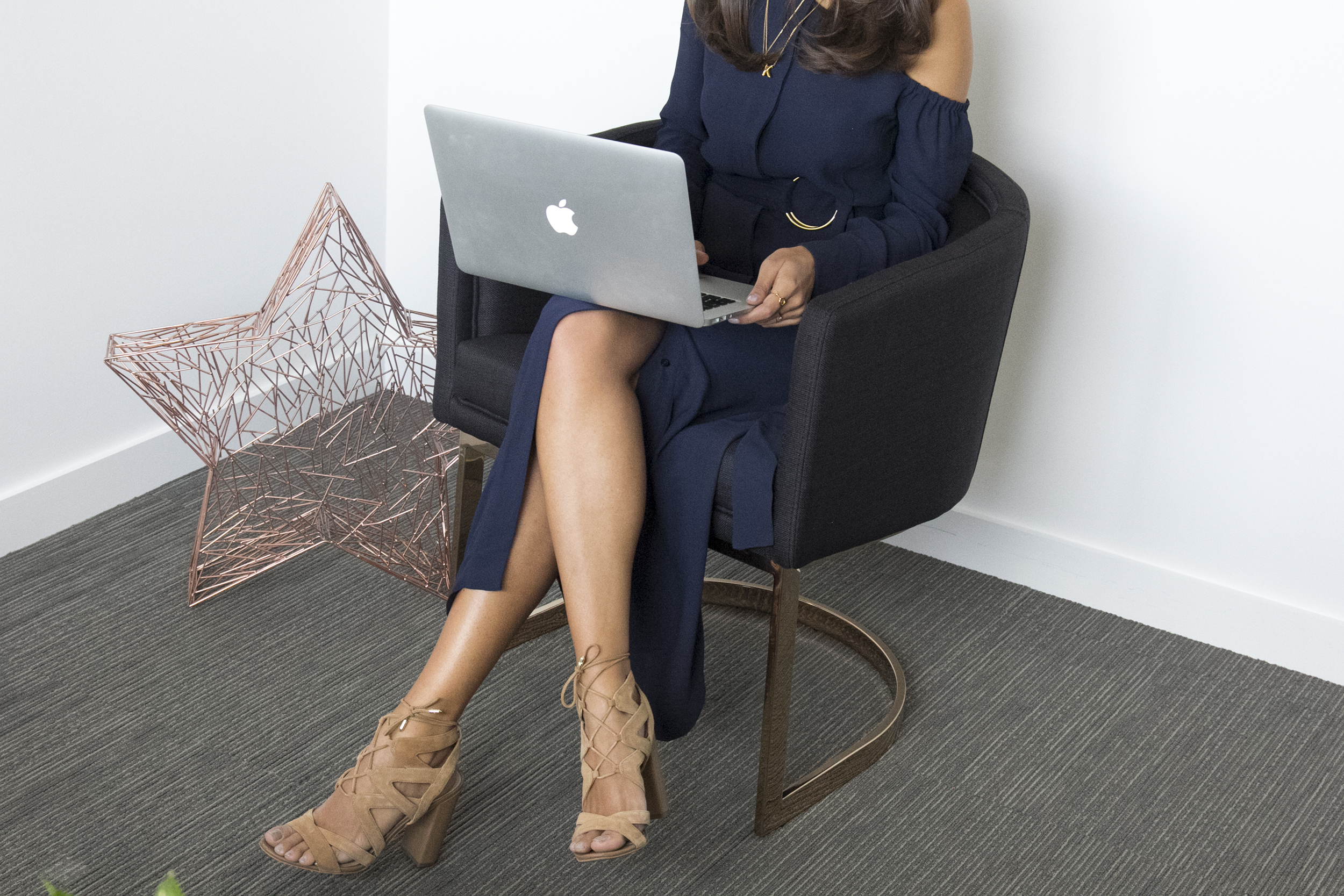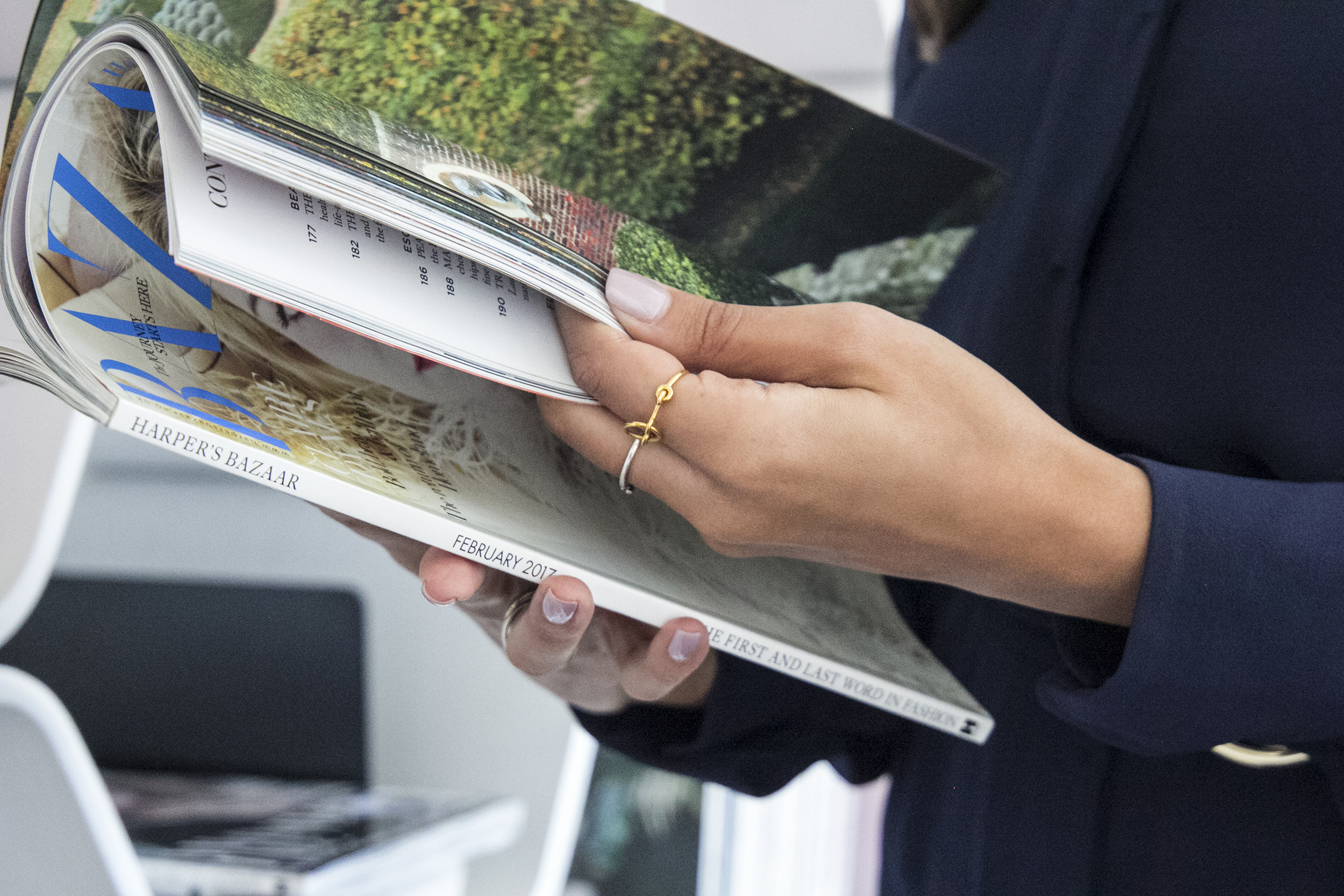Think back to your seventeen year old self. What were your interests? What were you good at? What did you want to achieve? I know what I was gently nudged towards (study) and advised against (drinking and boys), but my hopes and ambitions morphed with time and experience, rendering what I felt all those years ago now void. Isn’t it perplexing how much pressure we put on young adults to make lifelong decisions at such an early point in both life and career?
“I decided to do a degree in multimedia journalism at Bournemouth when everyone was encouraging me to study English instead,” Sarah Karmali tells us. “It allowed me to get hands on, practical experience and the space to decide which type of journalism suited me best,” she explains. Stints at Marie Claire, The Huffington Post and vogue.co.uk followed, before Sarah was offered the position of digital editor of Harper’s Bazaar. “It was never my original intention to work in the digital space,” she says. “I actually got into it by accident.”
“Having said that, I’ve been very strategic since,” she says. “I was always very targeted with the kind of publication I wanted to write for and the kind of career path I wanted to carve out—and I’ve always made sure to get a promotion with every move.”
From the basics of storytelling to creating digital strategy or growing profit, Sarah says she’s learned a lot from every job she’s ever had. “Switching jobs so frequently meant that I never got too comfortable and was always learning. Being agile is key to being successful in digital—if you don’t like change, then it’s not the industry for you.”
THE 411 ON HER WORK HISTORY FROM MARIE CLAIRE TO VOGUE: I decided to do a degree in multi-media journalism at Bournemouth when everyone was encouraging me to study English instead – and I’m so glad I did. Writing for a website, magazine or newspaper is an entirely different skill to writing an essay and it allowed me to get hands on, practical experience and the space to decide which type of journalism suited me best. I graduated with a ready-made set of contacts and a CV with some pretty impressive placements on it – plus a job offer. When I graduated, digital journalism was a totally different beast to what it is now – Instagram and Twitter didn’t exist. I enjoyed the fast pace of broadcast journalism and the content of women’s magazines, and I soon discovered that writing for magazine websites combined the best of both those worlds. I targeted magazines that I admired (and read) and started at InStyle and Marie Claire as digital intern and then digital writer, respectively. Working on such small online teams meant I was able to get experience across all areas of the site – I quickly learnt to say yes to everything, to put in the hours and always offer to do more. I then decided to experience working in a purely digital environment when Marie Claire’s digital editor at the time left to launch a women’s fashion and lifestyle site at AOL called MyDaily (which sadly no longer exists). I joined her there as senior writer and relished in being surrounded by an entire company of digitally minded people. It was here that I learnt everything there was to know about the tech side of things – analytics, product, traffic growth – and also worked on the launch of the UK edition of the Huffington Post. But I missed the world of women’s magazines and when a maternity position as News Editor at Vogue.co.uk became available, I jumped at the chance. There, I was responsible for co-editing the news section of the site and maintaining the title’s reputation as one of the world’s leading fashion news sources. After the year was up, I was offered the position of deputy editor at harpersbazaar.co.uk and after a year in that role, was promoted to digital editor.
THE UPSIDE OF MOVING JOBS OFTEN: I’ve learnt so much at every job that I’ve had – from the basics of writing news stories, creating shopping galleries and cropping pictures, to wider digital strategy, whether that’s increasing social engagement, growing traffic or creating a profitable digital business. The nature of digital means that it’s always changing; you have to constantly be able to adapt or you’ll get left behind. Switching jobs so frequently meant that I never got too comfortable and was always learning. Being agile is key to being successful in digital – if you don’t like change, it’s really not the industry for you!
 ACCIDENTALLY CARVING A CAREER IN DIGITAL: I’d been emailing Pat McNulty at InStyle during my degree to get work experience who I then got back in touch with when I graduated. What I didn’t realise was that in that time she’d moved over to the web team, so when I turned up on my first day that’s who I was sat with. It’s the happiest accident I’ve ever made. Having said that, I’ve been very strategic since. I had a period of no work in between InStyle and Marie Claire because I was holding out for a title that I really wanted to work for. I was always very targeted with the kind of publication I wanted to write for and the kind of career path I wanted to carve out. I always wanted to work in luxury women’s fashion and I’ve always made sure to get a promotion with every move. I’m very glad I was never tempted to sway away from digital, because now I can’t imagine doing anything else.
ACCIDENTALLY CARVING A CAREER IN DIGITAL: I’d been emailing Pat McNulty at InStyle during my degree to get work experience who I then got back in touch with when I graduated. What I didn’t realise was that in that time she’d moved over to the web team, so when I turned up on my first day that’s who I was sat with. It’s the happiest accident I’ve ever made. Having said that, I’ve been very strategic since. I had a period of no work in between InStyle and Marie Claire because I was holding out for a title that I really wanted to work for. I was always very targeted with the kind of publication I wanted to write for and the kind of career path I wanted to carve out. I always wanted to work in luxury women’s fashion and I’ve always made sure to get a promotion with every move. I’m very glad I was never tempted to sway away from digital, because now I can’t imagine doing anything else.
LIFE AT THE HELM OF HARPER’S BAZAAR ONLINE: My role involves overseeing the digital strategy for the whole brand – from editing every story that goes up on the site to overseeing all the social media channels. I work closely with the print team to make sure that the tone and quality of content on the site reflects that of the magazine and with the other digital editors at Hearst to ensure that harpersbazaar.co.uk is the best and most successful site that it can be.
GROWING TRAFFIC (IN A MAJOR WAY): Since I became digital editor, I’ve grown the site’s unique users by 370%, which has taken blood, sweat and tears, plus lots of working evenings and weekends. The key factors have been growing our social media audience, hiring a team of hard working, dedicated writers and editors and being able to respond quickly to what our audience is interested in. There’s so much noise on the internet; anyone with a phone and some confidence can be an Instagram influence; anyone with a laptop and an opinion can be a blogger. Harper’s Bazaar is a hugely well respected 150-year-old luxury title, and in an age where there’s too much to read and too many people to follow, those good quality heritage brands stand out. We’re the ones that readers know they can trust and come back to. We analyse what our readers enjoy the most and respond accordingly to make sure they keep coming back – while simultaneously delivering content that they didn’t even know they wanted until they read it.
THE COMMON PITFALL YOUNG WRITERS FALL INTO: They have a tendency to over-write. I always advise interns to ‘write how you speak’ – don’t try too hard to be the ‘brand’ or to be overly poetic, particularly for digital; write in the way that feels most natural and then the tone and house style will follow in time. You’re telling a story so focus on making that narrative clear. Also, just read, read, read. Discover the writing styles that you enjoy reading and be inspired by that.
THE RIGHT WAY TO PITCH YOUR WORK: Make sure that the content you’re pitching is suitable for the publication that you’re pitching it to. It sounds obvious, but if I don’t think that you get what Harper’s Bazaar stands for from your pitch then it’s unlikely I’ll trust you to write for the website. Also bear in mind that editors are very busy and often away from their desks – try targeting team writers or deputy editors instead. If they think it’s a good idea they’ll flag it with me.
THE PRESSURE TO CUT THROUGH THE NOISE: I want my team to produce informative, inspiring and engaging content that readers are going to enjoy and want to share – that’s first and foremost the most important thing. Then, you’ve got to consider how to compete for your reader’s attention (without resorting to click-bait techniques), and how to retain it once they’re on the site. You’ve got to be reactive, and join the conversation, while also thinking ahead and giving them what they want before they even know they want it. My main priority is to drive traffic to the site – whether that be via social, search or organic referrals – and get the number of monthly unique users up. But on-site traffic is really just one element of what we do; there’s brand building on Instagram, holding a captive audience on Facebook or providing talking points for Twitter to chew over. Essentially the strategy comes from taking all these things into consideration, while studying the data of what has performed well previously.
CREATING CONTENT FOR BIG EVENTS: You can split the majority of the content on our site into two categories; reactive and proactive. Big events like the Met Gala are huge traffic drivers for us and a successful execution will require a mixture of the two. We’ll plan ahead and create or update any evergreen content in the run-up to the event to share across the site and social media (i.e. most outrageous Met Gala moments in history, the 10 most spectacular Met Gala red-carpet dresses of all time, who was best dressed at last year’s Met Ball?). We’ll also have an editor working overnight on the night of the event to put up a gallery of the looks as they come in and add all the fashion credits – which we’ll either get from social media or directly from the brands. Then we’ll create any spin-off content the following morning depending on whether anything newsworthy happens, so that’s all entirely reactive. We might also run a Facebook poll, or put video clips on Instagram, pin our favourite dresses on Pinterest; there will be a different approach for each platform.
BALANCING DATA AND INSTINCT IN PLANNING STORIES: As editors, we’re always using our instincts – after all, we know our audience better than anyone – but we’re also constantly studying data to know what works and what doesn’t. We know which stories have performed best over the last day, week, month, year; we know who was reading those stories, where they came from and how long they stayed on the site for. We know that they love Amal Clooney, Emma Watson and Blake Lively, they’re keen to get the best possible skincare products and that health and fitness advice always piques their interest (for example). We use so many tools across the site and social media that are constantly monitoring our traffic, referrals and engagement – then we use that data to inform our content decisions going forward. If something didn’t perform as well as we’d hoped then we’ll try to understand why; was it the timing? Was the headline not attractive enough? Could we have used more beautiful imagery? It’s a constant work in progress.
ON CREATING A CONSISTENT EDITORIAL VOICE: Often, social media can be a reader’s first ever introduction to the brand – they might see a news story that’s been retweeted, or come across a video that’s been shared on Facebook, for example, so it’s vital that the tone and language used is always 100% reflective of the brand. We’ve recently hired a social media manager to help combat that exact problem – having one person solely focused on growing social audiences, while maintaining a consistent editorial tone – and it’s been one of the most important hires that I’ve made. Who would have known such a job would even exist five years ago?
 THE CONSTANT EVOLVING NATURE OF HER ROLE: It’s totally different to what it was when I first started, so in all honesty it’s hard to predict what it will look like in two years’ time. I should imagine on a very basic level it will require taking on more commercial responsibility, managing a larger team and focusing on more complex and in-depth strategy as the digital side of the business continues to grow. I love that the pace is fast. I’m the sort of person who, if given 30 days to complete a task, will start working on it on day 29, so the more immediate the deadline, the more productive I tend to be. Plus, it means I get to work on something different every day, which makes life more interesting!
THE CONSTANT EVOLVING NATURE OF HER ROLE: It’s totally different to what it was when I first started, so in all honesty it’s hard to predict what it will look like in two years’ time. I should imagine on a very basic level it will require taking on more commercial responsibility, managing a larger team and focusing on more complex and in-depth strategy as the digital side of the business continues to grow. I love that the pace is fast. I’m the sort of person who, if given 30 days to complete a task, will start working on it on day 29, so the more immediate the deadline, the more productive I tend to be. Plus, it means I get to work on something different every day, which makes life more interesting!
ON MISCONCEPTIONS ABOUT HER JOB: People think all it involves is getting free stuff and going on nice holidays. I blame social media for that. Yes, there are some great perks (ones that I didn’t know about when I started out in the industry, so that was a nice surprise), but you only get to take advantage of them if you work really, really hard. There are fewer and fewer jobs in magazine journalism now and more competition than ever, so if you don’t work your ass off then you won’t make it.
WHAT SHE’S LEARNT ABOUT COMING BACK FROM MISTAKES: We host regular Bazaar at Work reader events and there was a recent panel featuring Facebook VP Nicola Mendelson, who said something that really resonated with me; deal with your mistakes straight away and they become learnings, not failures. There’s always the temptation to bury your head in the sand when something goes wrong, but I’ve learnt to deal with it head on, and move on. The great thing about digital journalism is that it allows for a certain amount of trial and error (something which I actively encourage with my team); if you’ve got a great idea, let’s try it out and see how it performs. If it’s not as successful as we’d hoped it might be then let’s try and figure out why and develop it. But as the digital side of the business grows, so does the level of responsibility and the pressure to succeed; obviously there are always going to be moments of self-doubt, but I think as long as I’m always putting the content and the reader first, it will work out and I’ll feel happy with myself.
THE STRUGGLE TO SWITCH OFF WHEN YOUR JOB IS BEING SWITCHED ON: It’s one of the hardest parts of the job. There’s always another story you could publish, there’s always more traffic to gain; it’s not like with a magazine where you file your pages and send it to print; there’s an infinite amount of space to fill. I recently went on holiday for a week with a group of girlfriends and had to delete the Twitter and Facebook apps off my phone to stop me checking up. I’ve also tried to ban my phone and laptop for an hour before bed, but that’s much easier said than done… I think burn out is a risk when you work in digital – it really is constant. But you have to be aware that that might happen and take a step back once in a while if you’re feeling stressed or overworked. Having a good sense of perspective really helps; I love my job but there are far more important things in the world, we’re not saving lives or curing cancer. I’ve also got a brilliant team – in my opinion, one of the best in the business – and they are amazingly supportive. They all care about the site as much as I do and I’ve learnt the difficult lesson of delegation. No one can do everything by themselves, and thankfully I don’t have to.







An interesting insight into Sarah’s career and I totally agree that you can’t plan everything in your career. Being agile and open to opportunities is the key to success.